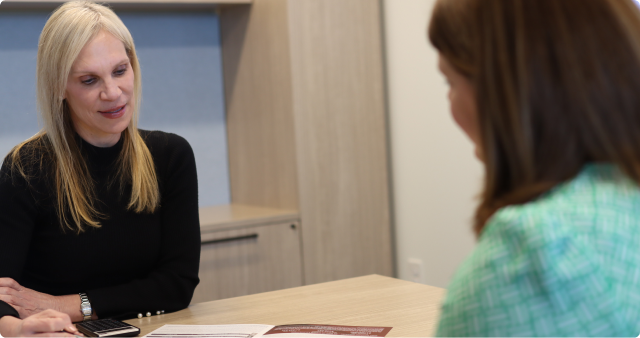Dive into the latest financial headlines, examine the impact of modern work-from-home trends, and explore the three most compelling economic charts of the moment. Analyze inflation as it edges up around 3%, raising questions about the Federal Reserve’s next move. Debate revaluation’s potential role in helping shrink the deficit by looking at how the U.S. Treasury’s gold reserves, still marked at outdated 1970s prices, would be worth over $750 billion at today’s value. Unpack the soaring manufacturing expectations that have come along with a massive spike in projected industrial activity. Dissect the latest attempt for government downsizing as roughly 75,000 federal workers have already accepted buyouts. Wes Moss and Jeff Lloyd help connect the dots and decode what this all means for the economy, the markets, and the financial future of retirees and beyond.
Read The Full Transcript From This Episode
(click below to expand and read the full interview)
- Wes Moss [00:00:02]:
The Q ratio, average convergence, divergence, basis points, and BS Financial shows. Love to sound smart, but on Money Matters, we want to make you smart. That’s why the goal is to keep you informed and empowered. Our focus, providing clear, actionable information without the financial jargon to help 1 million families retire sooner and happier. Bigger. Based on the long running WSB radio show, this Money Matters podcast is tailor made for both modern retirees and those still in the planning stages. Join us in this exciting new chapter and let’s journey toward a financially secure and joyful retirement together. Wes Moss along with Jeff Lloyd, who has sauntered into the studio here on a Sunday morning.Wes Moss [00:00:55]:
Jeff, what’s up?Jeff Lloyd [00:00:57]:
Good to be back on a Sunday morning here with you, Wes. And remember, tomorrow is a stock market and bank holiday.Wes Moss [00:01:04]:
Right? It’s. It. It’s President’s Day. President’s Day weekend.Jeff Lloyd [00:01:08]:
You know what? That’s what a lot of people call it. It’s actually not President’s Day. The official.Wes Moss [00:01:14]:
Yeah, hold on. Let me go.Jeff Lloyd [00:01:16]:
Fact check me.Wes Moss [00:01:17]:
What is it? Wait, what is it? What is it officially called?Jeff Lloyd [00:01:20]:
Officially, it’s called Washington’s birthday. And I think the reason that people call it President’s Day, they probably drive by a mattress or a furniture store and see the, you know, President’s Day sale sign waving in the front. But that’s actually not accurate.Wes Moss [00:01:35]:
George Washington would have been so proud. All those mattress sales.Jeff Lloyd [00:01:39]:
So the federal holiday was originally named after our first president, George Washington. Washington’s birthday. And the reason people started calling it President’s Day is because it’s actually close to Abraham Lincoln’s birthday as well. I think Abraham Lincoln was born February 12, and Washington was born February 22. So they just kind of grouped them together.Wes Moss [00:02:05]:
See, I’m sitting here thinking I’m gonna fact check you, but you just made such a compelling argument that I’m not even. I’m gonna take your word for it. I. I have a feeling you did a little bit of digging on this.Jeff Lloyd [00:02:16]:
I did a little bit of fact checking and digging, but it is Washington’s birthday.Wes Moss [00:02:22]:
Official name of the Federal hall is. You’re right. Started in 1885 to honor George Washington’s birthday. Wow. Okay, well.Jeff Lloyd [00:02:32]:
Yeah, well. And this will be the third stock market holiday of the year. We’ve already had New Year’s, we’ve had MLK Day, and now Washington’s birthday.Wes Moss [00:02:42]:
Everybody loves these three, these three day weekends. My kids love them, but because I have kids in different schools in different grades that nobody’s got the same Amount of time. Some have, I guess just the day. But then sports are rocking and rolling, so you gotta be back for practice even if you don’t school. And I’ve got a public school kid, he’s out of. He’s out of school, I think for winter break.Jeff Lloyd [00:03:02]:
You know what, we talked a couple weeks. We talked a little bit about working from home a couple weeks ago. And.Wes Moss [00:03:09]:
Yeah.Jeff Lloyd [00:03:10]:
How when the snow came through Atlanta, it didn’t mean you were going to miss a day of work. Like you were still able to work from home. Right?Wes Moss [00:03:17]:
You were.Jeff Lloyd [00:03:18]:
Our kids have a, what they call an E day on Friday. So they can.Wes Moss [00:03:23]:
The other day where they can go to school.Jeff Lloyd [00:03:25]:
They can go to school from home. They can school from home. So they have a couple of like assignments that they do on the computer.Wes Moss [00:03:35]:
Why don’t we. I thought that we would get something like that after the COVID years and the work from home, but you’re the only school I’ve ever heard that’s doing that. Is this the only time of the year that you’ve done it or do they do this?Jeff Lloyd [00:03:50]:
They had another one in the fall and I think it’s just so they can test the technology, bring the laptops home and interact with their teachers that way. So for our kids, it’s a four day weekend, not just a three day.Wes Moss [00:04:01]:
What do you mean? They gotta be on the laptop doing classes, don’t they?Jeff Lloyd [00:04:04]:
Just for. Not a full school day. The E days. It kind of reminds me of like back in Covid when you could be drunk. I know they were just rolling it out, but like sometimes our kids, school day, their E days, back during COVID they were done in like five minutes. The school day was over.Wes Moss [00:04:22]:
But if you think about it, I think about the Lloyd family truckster, the big good old fashioned American suv, whether it’s wi fi or cell. You could be on a road trip and the kids are doing their classes. But you’re two birds, one stone, highly efficient. They don’t have to make up a snow day.Jeff Lloyd [00:04:41]:
We’re traveling and doing school.Wes Moss [00:04:43]:
Yeah, yeah, I thought there’d be more of that, but. But we haven’t seen it at least. Look, you’re in Alabama. It’s a progressive state. Right. It’s one state closer to California. So you guys are always doing the new.Jeff Lloyd [00:04:54]:
You’re on the cutting edge, leading the way in education. That’s what Alabama is known for.Wes Moss [00:04:57]:
You’re always on the cutting edge. Speaking of, we try to lead our way when it comes to education. Right here On Money Matters today, the three most compelling economic data charts of our time here in this hour. Jeff Lloyd, how’s that for a.Jeff Lloyd [00:05:13]:
That’s a good little tease right there.Wes Moss [00:05:15]:
Tease. Because they really are fascinating charts and it’s not just because they’re interesting. There’s a lot that they say about the state of the economy and kind of the durability of where we stand right now in this, we’ve talked for the last couple of weeks now how it’s we, we’re not saying there’s an economic floor by any means, but pretty hard to, to get to a situation where 2025 doesn’t have a positive gross domestic product. Here we’re not talking about the stock market. We’re just talking about economic. The economic flywheel is moving. It’s got some velocity to it and maybe what’s the, what am I trying to think about in seventh grade physics? Mass times acceleration or speed gives it. What about the, what’s the word?Jeff Lloyd [00:06:00]:
Momentum.Wes Moss [00:06:00]:
Maybe it’s momentum. I’m looking. Yeah, we’re hard to slow down an object.Jeff Lloyd [00:06:04]:
Hey, at the break we’re going to pull up that equation.Wes Moss [00:06:07]:
Okay so we, we’ve got tomorrow of course is prep Washington’s birthday. Markets close. We’re going to get to economic charts. I want you to talk us through the inflation numbers. They came in a little hotter than expected.Jeff Lloyd [00:06:19]:
Came in a little bit hotter than expected. You remember the last print, the last time that we got inflation it was up 2.9%. So it was in that 2 range and had been Goldilocks. The Goldilocks.Wes Moss [00:06:31]:
Now before you get to it, can we, can I get to the most interesting stat of the finding of the week? Let’s hear it because I want it. We’re getting to, we’re getting to inflation. We all know about eggs egg prices. But this is mind blowing. This is mind blowing again. Say it’s a positive. The US treasury has held back when we went off the gold standard. I guess this is when this all started.Wes Moss [00:07:00]:
We back then and we still do to this day. We have the Treasury. United states treasury has 261 million troy ounces of gold sitting in their void. I don’t know if it’s physically there or they just own it, but it’s marked to the value back in early 1970. So it’s marked to like $42 per.Jeff Lloyd [00:07:25]:
Troy ounce per ounce.Wes Moss [00:07:27]:
Okay. So it’s still a lot of money but it’s not, not going to move the meter when it comes to our fiscal situation. Well what if we valued it at today’s gold price? Today’s gold price is, let’s call it round number. Right around 3,000.Jeff Lloyd [00:07:42]:
Close to 3,000 per ounce.Wes Moss [00:07:44]:
So there’s been some chatter about this and here we are. What do we see this week? Kind of the biggest news that came out of Washington was, you know, Musk and President Trump in the Oval Office talking about Doge and trying to balance the deficit. So we don’t have 2 trillion and annual deficit. So we’re looking for 2 trillion. Right. And so there’s been talk. Wait a minute. What if the Treasury’s 261 million troy ounces was valued in today’s dollars? What would it be? What’s 261 million times? Call it 3,000.Wes Moss [00:08:23]:
It’s over three quarters of a trillion dollars.Jeff Lloyd [00:08:29]:
Billion with a b. Yeah.Wes Moss [00:08:32]:
Almost three quarters of a trillion.Jeff Lloyd [00:08:33]:
Yeah.Wes Moss [00:08:34]:
Over 750 plus billion dollars is what that would be worth today. That’s crazy, isn’t it? Yeah, well, in a good way.Jeff Lloyd [00:08:42]:
No, that’s crazy to think where it’s valued now versus where it was valued back in the 70s because back then at, you know, roughly $40 an ounce, that equates to about 11 billion.Wes Moss [00:08:55]:
So it’s being carried at 11 billion. It’s really worth 750 plus billion.Jeff Lloyd [00:09:00]:
Yeah, that’s what they’re carrying it at on the, on the Fed balance sheet.Wes Moss [00:09:05]:
That is not just a small step towards the 2 trillion we’re looking for. Now, granted, not like we’re going to sell it and balance the budget all of a sudden. But it’s interesting as we are starting to look around and say how can, how can we balance a budget? Right. There’s of course great controversy around whether Doge, which is now made tons of headlines this year. Some people like what they’re doing, some people don’t like what they’re doing. In the end, not that many people are going to argue that we can’t run a $2 trillion deficit. We can’t continue to have 35 trillion plus in overall debt. We got to be able to start paying our bills because that number and the interest on the debt of course is eventually become a problem.Wes Moss [00:09:46]:
It’s, it’s not a near term problem though, is the good news that the interest we pay on the debt, it’s a lot. Still not anywhere close to having a materially negative impact on the economy. But if it doesn’t get better and there’s not some improvement around it, then eventually, of course, we’d have to start Worrying about that more. Looks like the government’s trying to do something about it. And that’s why I think statistics like this have popped up. People are looking.Jeff Lloyd [00:10:13]:
I kind of also came across an interesting article this past week that said about 75,000 US federal workers have already accepted the administration’s bailout program. Just the early buyout, the early bout. So just putting putting that into perspective, 75,000 already going in that buyout program. They’re about 2.3 million federal workers. So that’s about 3% of the federal workforce already going into that buyout program.Wes Moss [00:10:45]:
There was an interesting article this week I read about somebody who was in her 30s or 40s that took it and just said there was too much uncertainty. Just you hit the bid. So for that person, they can get another job. If you’re 62, it’s a little more tenuous. Are you going to go take the package and still be able to get another job? It’s a little harder, but it’s at least an opportunity for those that are, I think really close to retirement. But we’ll continue to touch on that as as that it looks like it’s settled, but who knows if that will resurface and there’ll be another buyout. We’ll say give me some inflation numbers, please.Jeff Lloyd [00:11:21]:
Yeah, so the, the latest print came out this past week. Inflation on a year over year basis, 3.0%. Now that’s the first time we’ve seen a print in the threes going back to June of 2024. So we kind of hit that Goldilocks in, in the sub 3 range. We got as low as, at least on a year over year basis, 2.4%. But since we hit that 2.4% in September, it’s ticked up. October, November, December. Now the January reading back at 3%.Jeff Lloyd [00:11:55]:
So inflation, I don’t want to call it heating up, but getting a little warmer.Wes Moss [00:12:03]:
Well in the Federal Reserve wants to, they’re probably going to be fine with two and change. You get to three and look, we all have some PTSD around inflation. I mean it was wreaked havoc on this economy and our wallets for several years as the inflation dragon awoke. It was kind of sleepy for a long time. Wham, we had 20% inflation over two years almost. And so we’re just keeping a really watchful eye on it and it’s heating back up. It probably means the Fed not lowering rates anytime soon. Tell us a little bit more about this 3% print.Wes Moss [00:12:42]:
Little beyond the Goldilocks. A little warmer Than expected. I wouldn’t put it in the just right camp. Where are these numbers coming from besides ags? And again, do we, do we already all know about eggs?Jeff Lloyd [00:12:54]:
But look, the eggs were the headline number. They were up 50% on a year over year basis that it’s almost $5 per dozen of eggs. If you go into the grocery store, I mean, that’s a lot. You got bacon up 6%. You got ham up 3.6%.Wes Moss [00:13:10]:
Bacon and bacon. Bacon, eggs and ham.Jeff Lloyd [00:13:13]:
Bacon, eggs and ham.Wes Moss [00:13:14]:
I can’t tell if you’re just being an all American guy talking about breakfast or you’re citing Dr. Seuss.Jeff Lloyd [00:13:20]:
Well, one of the items that we talked about that just needs to go away from the inflation report are video disk and other media.Wes Moss [00:13:28]:
Well, there’s so much Demand for video.Jeff Lloyd [00:13:30]:
19.6%. Yeah, we’re going to rename video disc. But one of the things I just kind of wanted to talk about is video discs.Wes Moss [00:13:38]:
They’re getting so expensive.Jeff Lloyd [00:13:39]:
You know, when we’re talking most. They’re extinct, they’re gone. They’re dinosaurs again.Wes Moss [00:13:43]:
Remember? That is really about streaming service.Jeff Lloyd [00:13:46]:
Streaming.Wes Moss [00:13:47]:
That’s what that really is.Jeff Lloyd [00:13:48]:
Yeah, we need to rename that to streaming services. But you know, when we talk about inflation, normally we’re talking numbers. Two and a half percent, 3%. We’re looking at it on a year over year basis. So right now we’re paying 3% more for a basket of goods than we were back this time last year. What I did was just kind of want to take a step back and go a little further and look back when we really saw inflation heating up. So, you know, normal inflation, healthy inflation for the economy is in that 1 to 2% or 2 to 3% range.Wes Moss [00:14:25]:
1 and a half to 2 and.Jeff Lloyd [00:14:25]:
A half, 1 and a half to 2 and and a half. That shows it’s a healthy economy that’s continuing to grow. If we go back four years, when inflation really started to rear its ugly head, it was about April of 2021. That’s when we saw inflation. The inflation print was 4.2%.Wes Moss [00:14:45]:
That got our attention.Jeff Lloyd [00:14:46]:
A year later it was 8%. That that June, it peaked at over 9%. So if I look at the numbers and I go back to that April 2021 time frame, what has overall inflation done? What does that look like for a basket of goods now compared to when inflation really started?Wes Moss [00:15:07]:
So if we fast forward it a couple months, we’re looking at 22, three, four. Four years. So if assuming we’re in April we’re almost four years. Okay, how much?Jeff Lloyd [00:15:17]:
So in aggregate, things are 20% more expensive than they were four years ago. Just wanted to put that into perspective. You know, we talk about compounding a lot and the power of compounding interest and what that means for your portfolio. But from an inflationary standpoint, that inflation continued to. To compound as well.Wes Moss [00:15:40]:
Yeah.Jeff Lloyd [00:15:41]:
And a 3% raise here, a 2 1/2% raise in prices in aggregate. I think the consumer had started to feel it over that timeframe.Wes Moss [00:15:50]:
Very few elixirs to slay the inflation dragon. The only one I know of is to also invest in assets that inflate along with inflation. More money matters straight ahead. If you’ve ever done a Jane Fonda workout or if you remember as a kid, Rocky running the steps, and if Michael keaton is still Mr. Mom to you, then guess what? It’s officially time to do some retirement planning. It’s Wes Moss from Money Matters. Weren’t those the good old days? Well, with a little bit of retirement planning, there are plenty of good days ahead. Schedule an appointment with our team today@yourwealth.com that’s y o u r your wealth dot com.Wes Moss [00:16:38]:
All right, so we’ve got three of the most. Just really look, I studied economics. I love markets. I love the economy. And so the data that we have here to share, these are three different ways of looking at different areas of the economy. One’s about inflation, one’s about manufacturing, and one’s about employment. And they’re some of the most compelling economic charts that I’ve seen in a very long time. And it’s hard to argue with calling this first one compelling because it’s about inflation expectations.Wes Moss [00:17:13]:
The University Michigan, for a very long time, done a survey for what do you think? Where’s inflation going to be? And inflation expectations do matter, because if you think you’re going to have a bunch of inflation, then sometimes it motivates you to just go ahead and purchase. Like if you think a house is going to be 10% more expensive next year, it somewhat motivates us. So expectations do matter. And the overall expectations for the survey, if you look at the University of Michigan survey for next year, are, if I’m drawing a line here, looks to be around 4%. The average American thinks inflation’s going to be 4% higher a year from now. We just got to print this week. It’s at three right now, so it stays. There will be three in a year from now, but we’ll see.Wes Moss [00:18:04]:
The jury’s still out on that. But this is what’s so fascinating is they also ask and split the group between Democrats, independents and Republicans. Jeff, tell us what the two different inflation expectations year out are. Let’s not look at the independents because they’re pretty much right on the overall survey. What about the other two groups?Jeff Lloyd [00:18:28]:
So like you said, overall 4% inflation expectation for next year, this time next year, if you look at just Democrats, they expect inflation to be a little bit higher than that. They expect it to come in at about 5%. If you look at Republicans, they think inflation is going to be zero. Zero inflation is going to be gone. It’s going to be at zero.Wes Moss [00:18:54]:
Wow. But that’s fascinating. You’ve got and the numbers just absolutely flip flopped after the election. But it’s fascinating to me to think that our country has such different opinions about the economy and that Republicans think inflation’s going to zero and Democrats think it’s going through the roof. It’s amazing.Jeff Lloyd [00:19:15]:
But these were expectations as of January. Let’s rewind a little bit and go back to pre election, let’s say the October timeframe. What did the overall inflation expectation look like? And then what did it look like between Republicans and Democrats? So going back a couple months, October, it’s, it’s in that 3 range. So but 3%. Republicans heading into the election said it was going to be 4.5%. Democrats expected it was going to be 2%. So hadn’t ended the election, Republicans thought inflation was going up. Hadn’t ended the election, Democrats thought inflation was going down.Jeff Lloyd [00:19:57]:
And then what happened post election just absolutely flip flopped, complete flip flop. Republicans say inflation’s going away, it’s going to be zero. Democrats say it’s going to be 5%.Wes Moss [00:20:09]:
And like any great debate, the answer is somewhere right in the middle. All right, the next thing to look at here, Jeff Lloyd, that is again about expectations which matter when it comes to the economy because it’s a social science. It’s a science about people, emotions, feelings, what we think is appropriate, what we think the world is going to look like so we can make some decisions. But we do this in manufacturing. The Philadelphia Fed survey, which is the Philly Fed Manufacturing Business Outlook Survey, shows us where manufacturers are thinking activity’s going. The reality is that manufacturing activity in the Philly Fed survey has been, well again, manufacturing in general really has been slightly in contraction in the United States, really going back to 2022. So we’ve had two, three years of just not dramatic contraction, but just under the 50% mark for manufacturing activity.Jeff Lloyd [00:21:12]:
Yeah, just the way it’s meas measured is that the baseline is at 50. So if we’re, if the reading is above 50, they call that expansion. So, you know, healthy manufacturing activity. If it’s below 50 and it could be, you know, 48, 49, that would be in contraction. And it’s like you said, over the last two to three years, it’s kind of been right around that 50 area.Wes Moss [00:21:36]:
What we’re looking at though too is that the Philly Fed survey closely tracks what overall manufacturing is doing. So it’s essentially almost tied. We get a little bit of an indication out of Philly Fed, and then overall manufacturing tends to follow. Well, again, if you look at what happened, Philadelphia Fed went from slight contraction to now a level of almost 65 in the last two months.Jeff Lloyd [00:22:04]:
Yeah, I know our listeners can’t see the chart that we’re looking at, but it just skyrocketed.Wes Moss [00:22:09]:
It spiked again. We’ve been hovering around 50 and just below 50 for three years now. Wham. Post election, the Philly Fed survey is showing that manufacturers think we’re going to get a massive surge in manufacturing. Now, time will tell if actual activity follows that, but again, I don’t, I don’t know if you want to call that animal spirits or just expectations that there’s going to be some more economic and manufacturing activity coming from those who are in the business of manufacturing. Interesting.Jeff Lloyd [00:22:42]:
And this chart goes back about 20 years. And these two lines closely track each other. So who knows what’s going to happen in the future, but history can show us that these are closely correlated.Wes Moss [00:22:54]:
Again, fascinating chart. And again, it’s about expectations. The first two were expectations. This one is about employment. And we’ve been talking now last couple of years about the job openings. So job vacancies, I think about a hotel with a sign that says, hey, we have vacancy. You drive by, you need a room, fine. If there are more people looking to get into the hotel, then there are rooms.Wes Moss [00:23:21]:
Again, more seekers than jobs. Rooms open, what happens? The hotel can charge more. And we saw this a couple years ago. We had the most wildest job overall employment market that we’ve seen really in my lifetime where we had two job openings for every one seeker. So the seeker could say, well, look, I’ve got two different jobs to choose from. So it’s a little inverse for my hotel analogy. But they can both say, look, I need more money. Hey, I’m seeking a job.Wes Moss [00:23:52]:
I can go here, you’re paying me X. I can go to the other job that’s open and get even more. What did it do? It caused wage inflation. And so when you have companies that have more demand to hire workers than the workers themselves, they got to pay more. So again, part of why we saw a bunch of inflation, what’s only recently happened, is that those two numbers are back in line. So instead of, I think it was 12 million job openings and 6 million people looking 2 to 1 today, we’re almost back to parity. Here we are at 7.6 million job openings and 6.8 million people looking. The ratio’s back to a 1.1.Wes Moss [00:24:30]:
Normally it should be 1. So it’s still a healthy job market for those seeking, but it’s loosened up a lot. And I think the takeaway here from that is we’re in a back to a much more normal labor market environment. Once that gets back into check where we and where we are today, even though we’ve been seeing hotter than normal inflation, this is one of the things that can soften some of the inflationary pressures that we’re seeing. But we’ll see. Jeff Lloyd, that, to me, is the fascinating economic chart of our day.Jeff Lloyd [00:25:01]:
Those were three fascinating things to look at.Wes Moss [00:25:04]:
Put it all together. It’s a pretty good sign that we’re seeing some momentum here for this economic flywheel.Jeff Lloyd [00:25:10]:
Yeah. And I did say we would pull up the formula for momentum. And that is mass times velocity.Wes Moss [00:25:18]:
Mass times velocity. That makes sense. Right? I think of a, A football player. Right. If you’re £160 and you’re fast and you’re running. Yeah. You know, you’re gonna. There’s.Wes Moss [00:25:30]:
There’s some.Jeff Lloyd [00:25:31]:
There’s some.Wes Moss [00:25:33]:
It’s mass times velocity equals momentum. Oh, momentum. Mass times or force. Momentum. Okay, so think about it. But if you’re, you know, 270 pounds and you’re running same speed, you’ve just got a whole lot more force and you have more momentum. And that’s what we’re seeing in this economy.Jeff Lloyd [00:25:54]:
And you’re going to make a bigger impact. The bigger you are, the faster you’re going. That’s the bigger impact. That’s the momentum.Wes Moss [00:26:00]:
And, and that’s this, the, the economic flywheel that has that right now. And it takes a lot to slow it down. Now, again, we’ll see inflation. It used to be called inflation matters. It’s been less of a concern here on money matters. If we start ticking up into the three low threes, 4%, I think the world will get a little bit nervous again. And the Federal have to start talking about what they’re going to do with interest rates. But you’ve got enough counter forces to inflation to see that.Wes Moss [00:26:28]:
I’m not, at least I’m not worried about it right now. I think inflation a little hotter than we want it to be. But you know what the timeframe we think about here on Money Matters, we’re tomorrow investors, so we’re thinking about not the economic data of the day. And I love bringing these charts to the table because they’re fascinating to me. But we’re looking out over the next year, next three years, next five years, the next 10 years. So we are tomorrow investors here. Money Matters. We’re happy retirees.Jeff Lloyd [00:26:59]:
We definitely are tomorrow investors, but we can’t invest tomorrow because it is a stock market holiday. So literally not. You can’t invest tomorrow. I’m sorry to our listeners, but we will invest for tomorrow and beyond.Wes Moss [00:27:14]:
Right? We just can’t do it actually.Jeff Lloyd [00:27:15]:
Just can’t do it tomorrow.Wes Moss [00:27:16]:
The market’s actually close. Again, thank you for that. You know, the, the holiday knowledge you brought to the table today actually made a lot of impact. It’s not President’s Day, it’s Washington’s birthday.Jeff Lloyd [00:27:27]:
Washington’s birthday tomorrow when the market’s closed.Wes Moss [00:27:30]:
All right, you’re listening to Money Matters. You can find Jeff Lloyd, me and the team@yourwealth.com y o u r wealth.com love to hear from you. Have a wonderful rest of your day.Speaker C [00:27:44]:
This is provided as a resource for informational purposes and is not to be viewed as investment advice or recommendations. This information is being presented without consideration of the investment objectives, risk tolerance or financial circumstances of any specific investor and might not be suitable for all investors. The mention of any company is provided to you for informational purposes and as an example only and is not to be considered investment advice or recommendation or an endorsement of any particular company. Past performance is not indicative of future results. Investing involves risk, including possible loss of principal. There is no guarantee offered that investment return, yield or performance will be achieved. The information provided is strictly an opinion and for informational purposes only and it is not known whether the strategies will be successful. There are many aspects and criteria that must be examined and considered before investing this information.Speaker C [00:28:32]:
Information is not intended to and should not form a primary basis for any investment decision that you may make. Always consult your own legal, tax or investment advisor before making any investment, tax, estate or financial planning considerations or decisions. Investment decisions should not be made solely based on information contained herein.
Call in with your financial questions for our team to answer: 800-805-6301
Join other happy retirees on our Retire Sooner Facebook Group: https://www.facebook.com/groups/retiresoonerpodcast
This information is provided to you as a resource for educational purposes and as an example only and is not to be considered investment advice or recommendation or an endorsement of any particular security. Investing involves risk, including the possible loss of principal. There is no guarantee offered that investment return, yield, or performance will be achieved. There will be periods of performance fluctuations, including periods of negative returns and periods where dividends will not be paid. Past performance is not indicative of future results when considering any investment vehicle. The mention of any specific security should not be inferred as having been successful or responsible for any investor achieving their investment goals. Additionally, the mention of any specific security is not to infer investment success of the security or of any portfolio. A reader may request a list of all recommendations made by Capital Investment Advisors within the immediately preceding period of one year upon written request to Capital Investment Advisors. It is not known whether any investor holding the mentioned securities have achieved their investment goals or experienced appreciation of their portfolio. This information is being presented without consideration of the investment objectives, risk tolerance, or financial circumstances of any specific investor and might not be suitable for all investors. This information is not intended to, and should not, form a primary basis for any investment decision that you may make. Always consult your own legal, tax, or investment advisor before making any investment/tax/estate/financial planning considerations or decisions.










